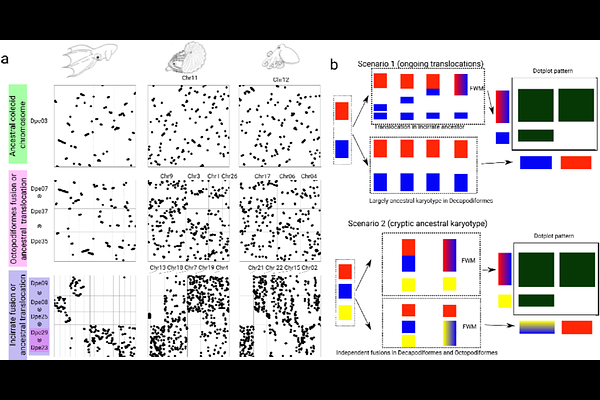Chromosomal fusions and subsequent rearrangements shaped octopus genomes

Chromosomal fusions and subsequent rearrangements shaped octopus genomes
Yoshida, M.-a.; Toth, E.; Kon-Nanjo, K.; Kon, T.; Hirota, K.; Toyoda, A.; Toh, H.; Miyazawa, H.; Terauchi, M.; Noguchi, H.; Setiamarga, D. H.; Simakov, O.
AbstractWhy some animal groups retain ancestral chromosomal complements while others change significantly is a fundamental question in evolutionary genomics. Few systems exist where accumulations of chromosomal changes can be studied in the context of morphological innovation. In coleoid cephalopods (octopus, squid, cuttlefish), an ancient coleoid chromosomal rearrangement event (ACCRE) has led to a substantial increase in the chromosome number and a new set of chromosomal homologies. Compared to typical molluscan or bilaterian genomes, ACCRE has enabled the origin of many novel regulatory regions in coleoid cephalopods. However, the discrepancies between extant octopodiform (octopus, ~30 chromosomes) and decapodiform (squid and cuttlefish, ~46 chromosomes) karyotypes and the direction of these evolutionary changes remain unexplained. Here we provide a draft genome assembly of the vampire squid Vampyroteuthis sp., the largest cephalopod genome sequenced to-date (over 10 gigabasepairs). Through syntenic comparisons, we infer that this basally branching octopodiform species shows partial retention of the chromosomal complement of Decapodiformes, indicating its more ancestrality, while at the same time also suggest the derived nature of the octopod karyotype. Together with the analysis of a new chromosome-level assembly of the pelagic octopod Argonauta hians, we identified irreversible chromosomal fusion-with-mixing events followed by inter-chromosomal translocations in octopods after their separation from the vampire squid lineage. This secondary reduction and mixing within octopod chromosomes has enabled the origin of a more entangled genomic configuration, shedding light onto the early evolutionary transitions within the clade. Our results offer broader insights into general patterns of chromosomal evolution following large-scale rearrangement events in animal genomes, and clarify the evolutionary trajectory leading to present-day coleoid diversity.